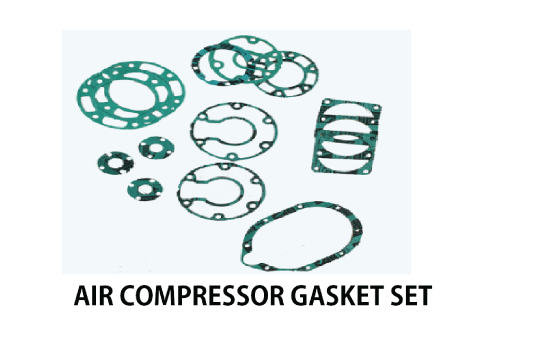-
Call
-
Whatsapp
9825014048
-
Location


Piston Compressor gasket Set
Piston Compressor gasket Set
Known for their reliability and versatility, piston compressors are critical to applications requiring compressed air or gas. Gasket sets for piston compressors play an important role in their reliable performance, but are often overlooked. These gasket seal sets are responsible for creating and maintaining an airtight seal in the compressor, ensuring proper operation, preventing leaks, and ultimately contributing to the compressor's overall performance.
This comprehensive guide discusses the piston compressor's importance, types, materials, and installed gaskets. We will examine installation and maintenance.
Piston compressors, also known as reciprocating compressors, work on the principle of using one or more pistons to compress air or air. These devices are widely used in various industries to power wind turbines, provide cooling for industrial components, compress air, etc. A piston compressor gasket set is a collection of gaskets and seals designed explicitly for use to prevent air or air leakage in the compressor.
Piston Compressor Gasket Sets Perform Several Essential Functions:
The cylinder in a piston compressor performs several essential functions:
- Air-bank sealing: The primary function of gasket sets is to provide an air-bank seal in the compressor. They do not allow air or compressed air to escape, making the pressure more efficient and less leaky.
- Heat Dissipation: The gasket helps dissipate heat generated during compression, preventing overheating and maintaining optimal operating temperatures.
- Vibration Dampening: These sets help reduce vibration and noise in the compressor, making it overall more stable and comfortable during operation.
- Protection Against Contamination: Gaskets act as an anti-fouling barrier, preventing foreign material from entering and damaging sensitive parts of the compressor.
- Corrosion Resistance: Many gasket materials are corrosion resistant, which is important for the compressor's long-term durability and reliability.
Gasket Sets
Piston compressor gasket sets come in various styles designed for specific compressor models and applications. The most common types are:
- Cylinder Head Gasket Sets: These sets include a gasket to seal the cylinder head to the block. They are also crucial for maintaining compression efficiency and preventing leaks in the compression chamber.
- Valve Plate Gasket Set: Valve plate gasket sets contain gaskets covering the valve plate to prevent air from entering the valve. They play an important role in controlling the intake and exhaust system.
- Complete Overhaul Gasket Sets: Complete overhaul gasket sets, including gaskets for compressor parts. They are used in a wide range of maintenance and repair procedures.
Material Gasket Sets
Gasket sets are made from various materials, each chosen for its unique characteristics and compatibility with compressor operating conditions. Common uses include:
- Non-Asbestos: Asbestos-free gaskets are known for their heat resistance and versatility. They are suitable for a wide range of temperatures and pressures.
- Graphite: Graphite gaskets provide excellent resistance to high temperatures and are commonly used at high temperatures.
- Rubber: Rubber gaskets provide flexibility, making them ideal for coatings with vibration or vibration.
- Steel: Steel gaskets are used at high pressures and high temperatures. They offer excellent strength and seal performance.
Installation and Maintenance
Proper installation and maintenance of gasket sets are essential to ensure optimum performance and longevity. Key considerations include:
- Surface preparation: The compressor surface must be clean and free of debris or old gasket material before installing a new set of gaskets.
- Torque Specification: Follow the manufacturer's recommended torque specifications when tightening bolts or fasteners to ensure adequate gasket compression and sealing.
- Routine inspection: Regular inspection should be done for any signs of gasket wear or damage. Any damaged or worn gaskets should be replaced immediately to prevent air leakage.
- Lubrication: In some cases, lubrication may be required to allow the gasket to soften and seal. Be sure to use compatible lubricants as recommended by the manufacturer.
Piston compressor gasket sets are the unsung heroes of the compressor world, ensuring an airtight seal, efficiency and long-term reliability. Seeing the need to invest in the proper installation and maintenance system and increase compressor efficiency, reducing downtime can also improve efficiency in various industrial applications.
As technology advances, gasket materials and designs change, improving performance and durability. By better understanding the functions, types, materials, and maintenance of gasket sets, businesses can harness piston compressor capabilities for various applications, from manufacturing to cooling.


FAQ

Frequently Ask Questions
A Piston Compressor Gasket Set typically includes various gaskets and seals required for the assembly and proper functioning of a piston compressor. This may include head gaskets, valve plate gaskets, cylinder gaskets, oil seals, and other necessary seals depending on the specific compressor model.
The replacement interval for a Piston Compressor Gasket Set can vary depending on factors such as compressor usage, operating conditions, and maintenance practices. However, it's generally recommended to inspect the gaskets regularly for signs of wear, leaks, or deterioration. If any issues are detected, the gasket set should be replaced promptly to prevent compressor performance issues and potential damage.
Signs of a worn or faulty Piston Compressor Gasket Set may include air leaks, oil leaks, decreased compression efficiency, abnormal compressor noises, and overheating. If you notice any of these symptoms, it's important to inspect the gaskets and seals for damage and replace them as necessary to maintain the proper functioning of the compressor.

